 |
 |
 |
| |
TMC278, a next-generation NNRTI, demonstrates potent and sustained efficacy in antiretroviral (ARV)-naive patients: Week 48 primary analysis of study TMC278-C204
|
| |
| |
Reported by Jules Levin
11th European AIDS Conference, Oct 24-27, 2007, Madrid, Spain
P Yeni,1 F Goebel,2 M Thompson,3 S Vanveggel,4 M Peeters,4 M Stevens,4 P Williams,4 B Woodfall,4 K Boven5
1Hopital Bichat, Paris, France; 2Ludwig-Maximilians University, Munich, Germany; 3AIDS Research Consortium of Atlanta, Atlanta, USA;
4Tibotec BVBA, Mechelen, Belgium, 5Tibotec Inc., Yardley, PA, USA
Abstract
Aims: TMC278 is a next-generation NNRTI entering Phase III. We report the
Week 48 intent-to-treat (ITT) primary analysis of an ongoing randomised Phase IIb study of TMC278 in ARV-naive patients (TMC278-C204).
Methods: Patients received blinded TMC278 (25, 75 or 150mg qd) or open-label
efavirenz (EFV; 600mg qd) plus AZT/3TC or TDF/FTC. The primary objective was to evaluate the TMC278 efficacy dose-response relationship at Week 48.
Results: 368 patients (33% female) were randomised; 76% received AZT/3TC, 24% TDF/FTC. No significant differences in efficacy were observed among the TMC278 groups, or compared with EFV at Week 48.
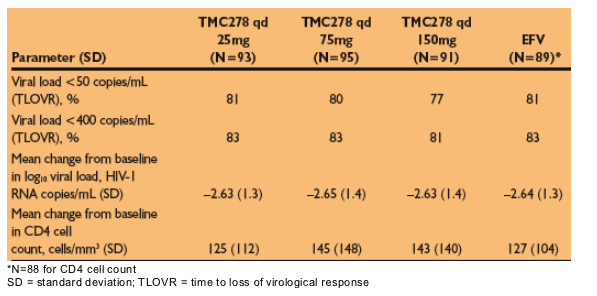
*N=88 for CD4 cell count
SD = standard deviation; TLOVR = time to loss of virological response
Most common adverse events (AEs), irrespective of causality, were nausea (TMC278 groups combined 35.1% vs EFV 29.2%) and headache (18.3% vs 15.7%). Rashes (7.9% vs 19.1%, p=0.002), vertigo (1.1% vs 11.2%, p<0.0001) and nervous system AEs (33.3% vs 52.8%, p=0.002) were significantly less frequent with TMC278 than with EFV, as were lipid increases. Incidence of psychiatric AEs was 13.3% vs 15.7%, respectively. Most frequent nervous system and psychiatric AEs were headache, dizziness and insomnia. For
TMC278 vs EFV, incidences of serious AEs were 10.4% vs 9%, grade 3/4 AEs 24.7% vs 15.7% (p=0.08) and grade 3/4 laboratory abnormalities 21.5% vs 20.2%. Trends from virological failure, safety and pharmacokinetic data favoured TMC278 75mg qd.
Conclusions: TMC278 demonstrated potent and sustained efficacy over 48 weeks in ARV-naive patients and was generally well tolerated with lower incidences of nervous system AEs, rash and lipid elevations than EFV. TMC278 75mg qd was selected for further development.
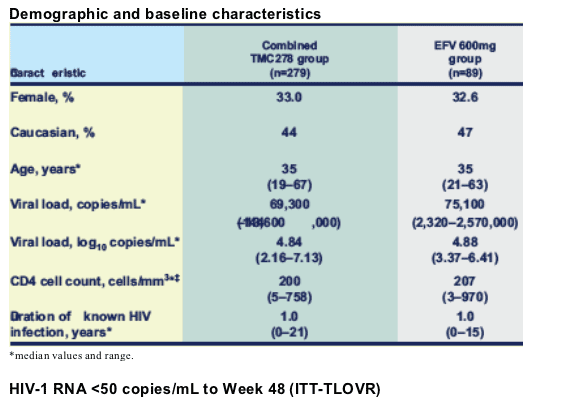
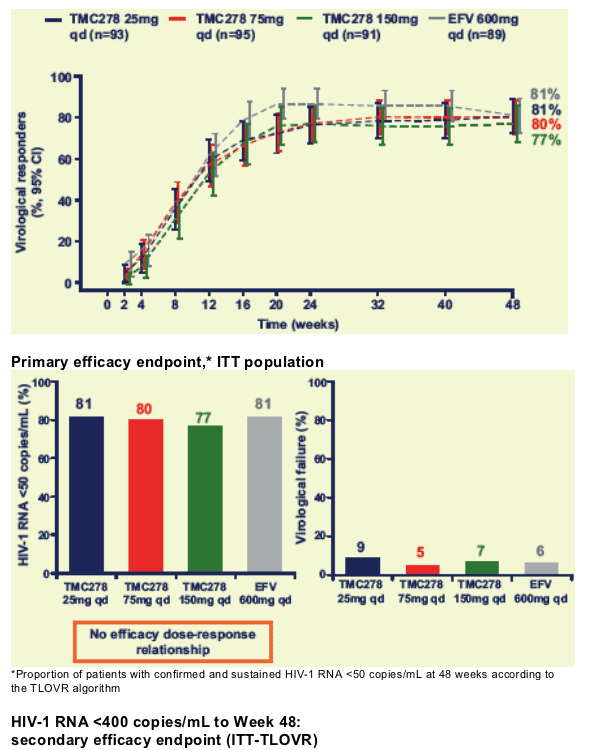
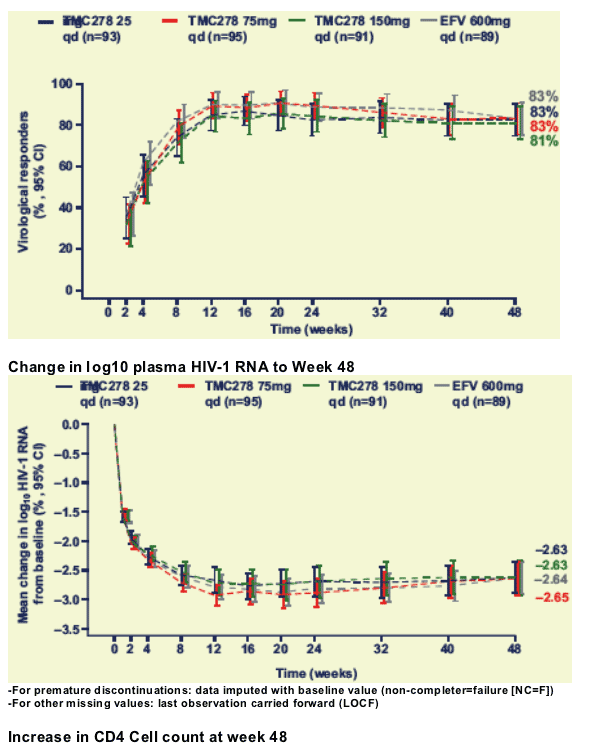
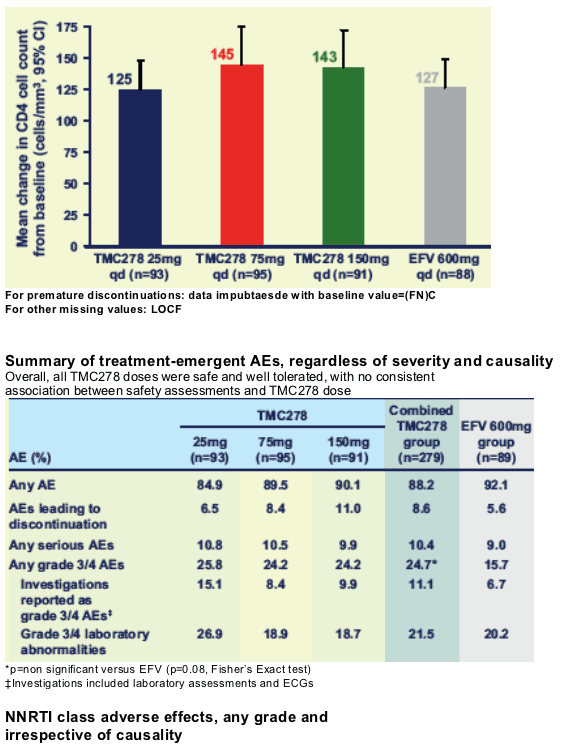
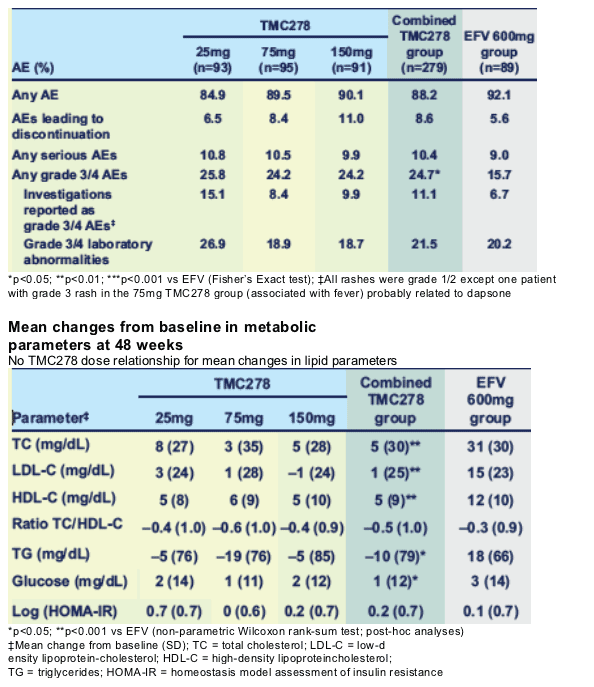
Conclusions
⋅ TMC278 demonstrated potent and sustained antiviral efficacy over 48 weeks: 77-81% (HIV-1 RNA <50 copies/mL; TLOVR).
⋅ TMC278 was generally safe and well tolerated.
⋅ Incidences of rash, central nervous system and psychiatric-related AEs and changes in lipid parameters were significantly lower with TMC278 than with EFV.
⋅ The 75mg dose, one pill qd, has been selected for further development in treatment-naive HIV patients.
|
| |
|
 |
 |
|
|